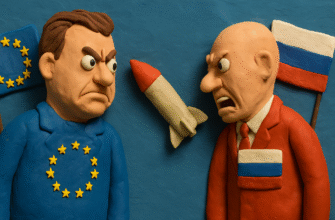On October 31, 2024, an official video was posted on the YouTube channel of the Belarusian publishing house “Belarus Today,” which is owned and controlled by the Belarusian government. The video had a striking title: The Road to the EU Is a Dead End. Why Eurointegration Is No Longer Attractive. In this video, analyst Aleksey Avdonin from the state think tank Belarusian Institute for Strategic Research (BISR) shared the following:
The very idea of Eurointegration has discredited itself, primarily because there is no real integration happening for countries that are candidates for EU membership. Eurointegration in Ukraine began with the first Maidan, with requirements to meet all conditions, which led to war. Eurointegration in Poland and the Baltic countries led to the destruction of their agriculture, farmers, and local enterprises, and a massive outflow of labor. Everyone now understands that Eurointegration is just a form of deception used by the West to achieve its key goals.
We attempted to analyze:
Verdict: Completely Inaccurate Information
Economic growth, supported by data on GDP per capita, as well as improvements in quality of life and happiness indices, clearly demonstrate the importance and benefits of EU integration for the people of the Baltic states and the Republic of Poland.
Rating scale
First, let’s look at the state of the economies. For this, we’ll choose GDP per capita, which, though somewhat outdated, still serves as a fundamental indicator. GDP per capita is the total value of all goods and services produced by a country in a year, divided by the number of residents, reflecting average economic productivity per person.  Data source: WorldBank Data.
Data source: WorldBank Data.
In 1995, the indicators for all countries were nearly the same, but over 30 years, significant changes occurred in their economies and quality of life.
According to the International Monetary Fund (IMF) data for 2023, 21 countries have a nominal gross domestic product (GDP) of over $800 billion:
20. Switzerland — $885.1 billion
21. Poland — $808.4 billion
We also discovered an unexpected fact that Lithuania’s GDP surpassed (sic!) Belarus’s GDP in 2023 by 6 billion USD:  This happened despite a threefold difference in population!
This happened despite a threefold difference in population!
However, GDP per capita does not always directly reflect the quality of life:
- Income Inequality: High GDP may be concentrated among a small group, while the majority lives in poverty.
- Cost of Living: High-GDP countries often have higher prices for housing, food, and services.
- Social Factors: GDP does not consider:
- Quality and accessibility of healthcare
- Education
- Environmental conditions
- Social guarantees
A more accurate picture is provided by composite indices, such as:
- Quality of Life Index
- Happiness Index
Quality of Life Index  The graphs show a consistent gap between countries:
The graphs show a consistent gap between countries:
- Estonia consistently leads
- Poland, Lithuania, and Latvia form the second group
- Belarus and Ukraine lag significantly, with a gap of about 20-30 points
The data are based on the Numbeo methodology, which takes into account:
- Purchasing power
- Safety
- Healthcare
- Cost of living
- Property price to income ratio
- Commute time
- Pollution
- Climate
Data source: Quality of Life.
Happiness Index

Key observations:
- Poland leads with a score above 6.0
- The Baltic countries show consistent growth
- Belarus shows a decline from 5.8 to 5.5
- Ukraine remains at the bottom, but with a tendency for growth despite the ongoing war since 2014.
The data are based on Gallup World Poll surveys, making them more objective compared to government statistics. Data source: World Happiness Report.
Further analysis of disinformation narratives:
- Discrediting European integration: The author claims that European integration has “”discredited itself””, which implies that the integration process not only does not bring benefits, but also leads to negative consequences. This claim may be disinformation, as it ignores the positive aspects of European integration, such as economic growth, improved living standards, and the strengthening of democratic institutions in some countries.
- Linking European integration to war: The claim that European integration led to the war in Ukraine is a strong disinformation narrative. This claim simplifies the complex geopolitical and historical factors that led to the conflict and tries to place the blame on the European integration process, which may be misleading.
- Negative consequences for agriculture and the economy: The author claims that European integration has led to the “”destruction”” of agriculture and the outflow of labor in Poland and the Baltic states. This claim may be misleading, as it does not take into account the context of changes in the economies of these countries, as well as possible benefits, such as access to new markets and investments.
- Deception by the West: The phrase that European integration is “”a form of deception”” implies that the West is deliberately misleading countries in order to achieve its goals. This creates an image of the West as manipulator, which may contribute to anti-Western sentiments and increase divisions between countries.
- Generalizations and simplifications: The text contains many generalizations, such as “”everyone understands”” that European integration is a deception. This creates the illusion of unanimity of opinion, which may be misleading, as it does not take into account the diversity of opinions and experiences of different countries and their citizens.
Overall, the text contains a number of disinformation narratives that are aimed at discrediting European integration and creating a negative image of the West, which can influence public opinion and political sentiment.










